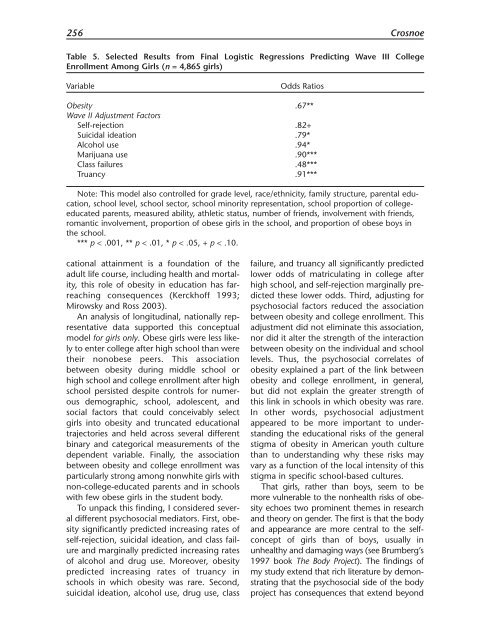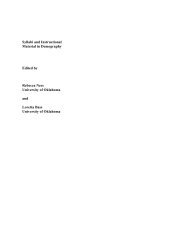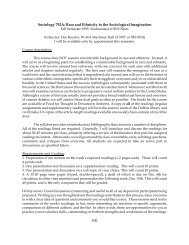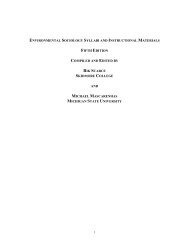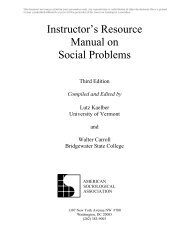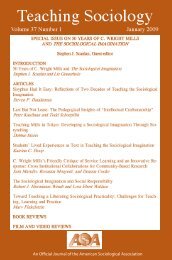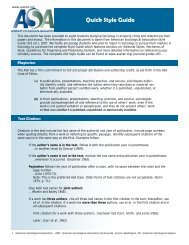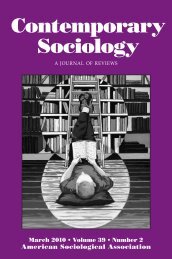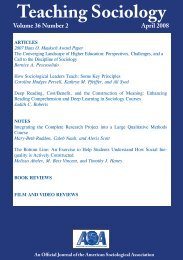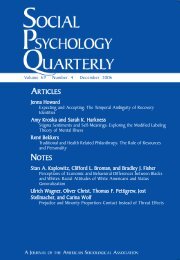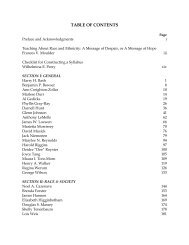SOCIOLOGY EDUCATION - American Sociological Association
SOCIOLOGY EDUCATION - American Sociological Association
SOCIOLOGY EDUCATION - American Sociological Association
Create successful ePaper yourself
Turn your PDF publications into a flip-book with our unique Google optimized e-Paper software.
256 Crosnoe<br />
Table 5. Selected Results from Final Logistic Regressions Predicting Wave III College<br />
Enrollment Among Girls (n = 4,865 girls)<br />
Variable Odds Ratios<br />
Obesity .67**<br />
Wave II Adjustment Factors<br />
Self-rejection .82+<br />
Suicidal ideation .79*<br />
Alcohol use .94*<br />
Marijuana use .90***<br />
Class failures .48***<br />
Truancy .91***<br />
Note: This model also controlled for grade level, race/ethnicity, family structure, parental education,<br />
school level, school sector, school minority representation, school proportion of collegeeducated<br />
parents, measured ability, athletic status, number of friends, involvement with friends,<br />
romantic involvement, proportion of obese girls in the school, and proportion of obese boys in<br />
the school.<br />
*** p < .001, ** p < .01, * p < .05, + p < .10.<br />
cational attainment is a foundation of the<br />
adult life course, including health and mortality,<br />
this role of obesity in education has farreaching<br />
consequences (Kerckhoff 1993;<br />
Mirowsky and Ross 2003).<br />
An analysis of longitudinal, nationally representative<br />
data supported this conceptual<br />
model for girls only. Obese girls were less likely<br />
to enter college after high school than were<br />
their nonobese peers. This association<br />
between obesity during middle school or<br />
high school and college enrollment after high<br />
school persisted despite controls for numerous<br />
demographic, school, adolescent, and<br />
social factors that could conceivably select<br />
girls into obesity and truncated educational<br />
trajectories and held across several different<br />
binary and categorical measurements of the<br />
dependent variable. Finally, the association<br />
between obesity and college enrollment was<br />
particularly strong among nonwhite girls with<br />
non-college-educated parents and in schools<br />
with few obese girls in the student body.<br />
To unpack this finding, I considered several<br />
different psychosocial mediators. First, obesity<br />
significantly predicted increasing rates of<br />
self-rejection, suicidal ideation, and class failure<br />
and marginally predicted increasing rates<br />
of alcohol and drug use. Moreover, obesity<br />
predicted increasing rates of truancy in<br />
schools in which obesity was rare. Second,<br />
suicidal ideation, alcohol use, drug use, class<br />
failure, and truancy all significantly predicted<br />
lower odds of matriculating in college after<br />
high school, and self-rejection marginally predicted<br />
these lower odds. Third, adjusting for<br />
psychosocial factors reduced the association<br />
between obesity and college enrollment. This<br />
adjustment did not eliminate this association,<br />
nor did it alter the strength of the interaction<br />
between obesity on the individual and school<br />
levels. Thus, the psychosocial correlates of<br />
obesity explained a part of the link between<br />
obesity and college enrollment, in general,<br />
but did not explain the greater strength of<br />
this link in schools in which obesity was rare.<br />
In other words, psychosocial adjustment<br />
appeared to be more important to understanding<br />
the educational risks of the general<br />
stigma of obesity in <strong>American</strong> youth culture<br />
than to understanding why these risks may<br />
vary as a function of the local intensity of this<br />
stigma in specific school-based cultures.<br />
That girls, rather than boys, seem to be<br />
more vulnerable to the nonhealth risks of obesity<br />
echoes two prominent themes in research<br />
and theory on gender. The first is that the body<br />
and appearance are more central to the selfconcept<br />
of girls than of boys, usually in<br />
unhealthy and damaging ways (see Brumberg’s<br />
1997 book The Body Project). The findings of<br />
my study extend that rich literature by demonstrating<br />
that the psychosocial side of the body<br />
project has consequences that extend beyond


